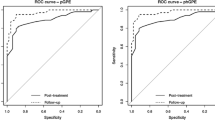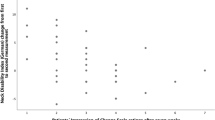Abstract
Purpose
To evaluate the responsiveness and minimal important changes (MICs) for the Italian Neck Disability Index (NDI) and Neck Pain Disability Scale (NPDS) as well as which questionnaire was the most responsive in subjects with chronic neck pain (NP).
Methods
At the beginning and end of an 8-week rehabilitation programme, 200 patients completed the NDI and NPDS. After the programme, the global perceived effect (GPE) was also evaluated and collapsed to produce a dichotomous outcome (improved vs. stable). Responsiveness was calculated by distribution [effect size (ES); standardised response mean (SRM)] and anchor-based methods (ROC curves; correlations between change scores of NPDS and NDI, and GPE). ROC curves were also used to compute the best cutoff levels between improved and stable subjects (MICs).
Results
The ES was 0.66 and 0.73, and the SRM was 1.09–1.26 for the NDI and NPDS, respectively. The ROC analyses revealed AUCs of 0.96 and 0.91 for the NDI and NPDS, respectively; the MICs were 7-percentage points for the NDI (sensitivity: 98 %; specificity: 81 %) and 10 for NPDS (93; 83 %), showing equivalent responsiveness properties. Baseline NPDS scores did not affect MIC estimate for the NPDS, while, for the NDI, higher MICs were found for patients with worst disability levels. Correlations between change scores of the NDI and NPDS and GPE were, respectively, high (0.71) and moderate (0.59).
Conclusions
The Italian NDI and NPDS were equally sensitive in detecting clinical changes in subjects with chronic NP undergoing rehabilitation. We recommend taking the MICs into account when assessing patient improvement or planning studies in this clinical context.


Similar content being viewed by others
References
Revicki D, Hays RD, Cella D, Sloan J (2008) Recommended methods for determining responsiveness and minimally important differences for patient-reported outcomes. J Clin Epidemiol 61:102–109
Mokkink LB, Terwee CB, Patrick DL, Alonso J, Stratford PW, Knol DL, Bouter LM, de Vet HC (2010) The COSMIN study reached international consensus on taxonomy, terminology, and definitions of measurement properties for health-related patient reported outcomes. J Clin Epidemiol 63(7):737–745
de Vet HC, Terwee CB, Ostelo RW, Beckerman H, Knol DL, Bouter LM (2006) Minimal changes in health status questionnaires: distinction between minimally detectable change and minimally important change. Health Qual Life Outcomes 4:54
Vernon H, Mior S (1991) The Neck Disability Index: a study of reliability and validity. J Manipulative Physiol Ther 14:409–415
Vernon H (2008) The Neck Disability Index: state-of-the-art, 1991–2008. J Manipulative Physiol Ther 31:491–502
Wheeler AH, Goolkasian P, Baird AC, Darden BV 2nd (1999) Development of the Neck Pain and Disability Scale: item analysis, face, and criterion-related validity. Spine 24:1290–1294
Goolkasian P, Wheeler AH, Gretz SS (2002) The neck pain and disability scale: test-retest reliability and construct validity. Clin J Pain 18:245–250
Monticone M, Ferrante S, Vernon H, Rocca B, Dal Farra F, Foti C (2012) Development of the Italian version of the Neck Disability Index. Cross-cultural adaptation, factor analysis, reliability, validity and sensitivity to change. Spine (Phila Pa 1976) 37(17):E1038–E1044
Monticone M, Baiardi P, Nido N, Righini C, Tomba A, Giovanazzi E (2008) Development of the Italian version of the Neck Pain and Disability Scale, NPDS-I. Spine (Phila Pa 1976) 33:E429–E434
Husted JA, Cook RJ, Farewell VT, Gladman DD (2000) Methods for assessing responsiveness: a critical review and recommendations. J Clin Epidemiol 53:459–468
Mokkink LB, Terwee CB, Knol DL, Stratford PW, Alonso J, Patrick DL, Bouter LM, de Vet HC (2010) The COSMIN checklist for evaluating the methodological quality of studies on measurement properties: a clarification of its content. BMC Med Res Methodol 18(10):22
Monticone M, Baiardi P, Vanti C, Ferrari S, Nava T, Montironi C, Rocca B, Foti C, Teli M (2012) Chronic neck pain and treatment of cognitive and behavioural factors. Results of a randomised controlled clinical trial. Eur Spine J 21(8):1558–1566
Kamper SJ, Ostelo RW, Knol DL, Maher CG, de Vet HC, Hancock MJ (2012) Global perceived effect scales provided reliable assessments of health transition in people with musculoskeletal disorders, but ratings are strongly influenced by current status. J Clin Epidemiol 63:760–766
Zweig M, Campbell G (1993) Receiver-operating characteristic (ROC) plots: a fundamental evaluation tool in clinical medicine. Clin Chem 39:561–577
Schuller W, Ostelo RW, Janssen R, de Vet HC (2014) The influence of study population and definition of improvement on the smallest detectable change and the minimal important change of the neck disability index. Health Qual Life Outcomes 12(1):53
de Vet HCW, Terwee CB, Mokkink LB, Knol DL (2011) Measurement in medicine. A practical guide. Cambridge University Press, Cambridge
Bronfort G, Evans R, Nelson B, Aker PD, Goldsmith CH, Vernon H (2001) A randomized clinical trial of exercise and spinal manipulation for patients with chronic neck pain. Spine 26:788–797
Evans R, Bronfort G, Nelson B, Goldsmith CH (2002) Two-year follow-up of a randomized clinical trial of spinal manipulation and two types of exercise for patients with chronic neck pain. Spine 27:2383–2389
Hoving JL, Koes BW, de Vet HC, van der Windt DA, Assendelft WJ, van Mameren H, Devillé WL, Pool JJ, Scholten RJ, Bouter LM (2002) Manual therapy, physical therapy, or continued care by a general practitioner for patients with neck pain—a randomized, controlled trial. Ann Intern Med 136:713–722
Kjellman G, Oberg B (2002) A randomized clinical trial comparing general exercise, McKenzie treatment and a control group in patients with neck pain. J Rehabil Med 34:183–190
Hoving JL, De Vet HCW, Koes BW, van Mameren H, Deville WLJM, van der Windt DAWM, Assendelft WJJ, Pool JJM, Scholten RJPM, Korthals–De Bos IBC, Bouter LM (2006) Manual therapy, physical therapy, or continued care by the general practitioner for patients with neck pain—long-term results from a pragmatic randomized clinical trial. Clin J Pain 22:370–377
Kietrys DM, Galper JS, Verno V (2007) Effects of at-work exercises on computer operators. Work 28:67–75
Lee H, Nicholson LL, Adams RD, Maher CG, Halaki M, Bae SS (2006) Development and psychometric testing of Korean language versions of 4 neck pain and disability questionnaires. Spine 31:1841–1845
Kose G, Hepguler S, Atamaz F, Oder G (2007) A comparison of four disability scales for Turkish patients with neck pain. J Rehabil Med 39:358–362
Stratford PW, Riddle DL, Binkley JM, Spadoni G, Westaway MD, Padfield B (1999) Using the Neck Disability Index to make decisions concerning individual patients. Physiother Can 51:107–112
Pool JJ, Ostelo RW, Hoving JL, de Bouter LM, Vet HC (2007) Minimal clinically important change of the Neck Disability Index and the Numerical Rating Scale for patients with neck pain. Spine 32:3047–3051
Cleland JA, Childs JD, Whitman JM (2008) Psychometric properties of the Neck Disability Index and Numeric Pain Rating Scale in patients with mechanical neck pain. Arch Phys Med Rehabil 89(1):69–74
Young BA, Walker MJ, Strunce JB, Boyles RE, Whitman JM, Childs JD (2009) Responsiveness of the Neck Disability Index in patients with mechanical neck disorders. Spine J 9(10):802–808
Jorritsma W, Dijkstra PU, de Vries GE, Geertzen JH, Reneman MF (2012) Detecting relevant changes and responsiveness of Neck Pain and Disability Scale and Neck Disability Index. Eur Spine J 21(12):2550–2557.24
Acknowledgments
The authors would like to thank all the physiotherapists who took part in the study.
Conflict of interest
None.
Ethical standard
Our institutional review board approved the research and the study was conducted in conformity with ethical and humane principles of research.
Author information
Authors and Affiliations
Corresponding author
Rights and permissions
About this article
Cite this article
Monticone, M., Ambrosini, E., Vernon, H. et al. Responsiveness and minimal important changes for the Neck Disability Index and the Neck Pain Disability Scale in Italian subjects with chronic neck pain. Eur Spine J 24, 2821–2827 (2015). https://doi.org/10.1007/s00586-015-3785-5
Received:
Revised:
Accepted:
Published:
Issue Date:
DOI: https://doi.org/10.1007/s00586-015-3785-5




